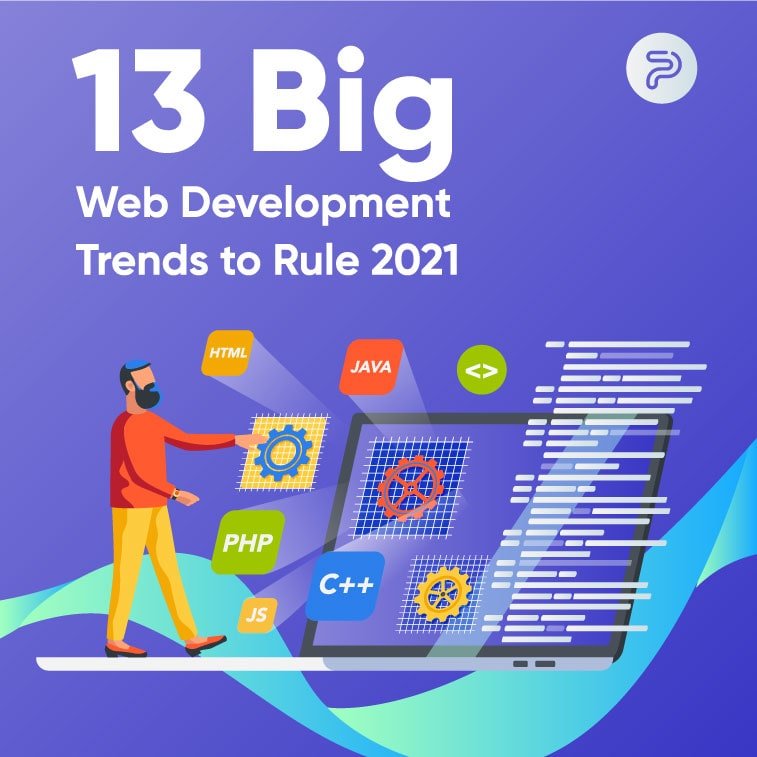As we are entering the last third of 2020, it's a perfect time to take a more thorough look at the upcoming trends in web development.
According to some stats, there are around 1.8 billion sites on the web and most of us will never visit even 10 percent of them. However, it’s worth noting, that nearly every one of these sites, in one way or another, contributes something to the ever-changing world of web development.
The truth is, when it comes to web development, standards and trends tend to shift faster than developers can implement them. As such, it’s always necessary to keep yourself up-to-date with the latest trends, especially if you are working in this particular industry.
We are talking about changes that take place so fast, that even the most revolutionary shifts will only just expand the paradigm of web development at first, instead of changing it altogether.
So, what does web development hold for the upcoming year?
1. Progressive Web Applications (PWA)
If you’ve been around the block a couple of times, you’ve already heard about progressive web apps since they aren’t the “hottest thing” of the year, however, developers finally received the attention and funding needed to further develop Progressive Web Apps into something that performs outstandingly, providing high-quality user experience.
So, what’s all the fuss about progressive web applications? Their main objective is to provide users who are browsing through mobile with the same speed and other convenient features as if they were using a laptop or desktop by using HTML, CSS, and JavaScript web technologies. They offer offline mode, interactive web, and responsive experiences, all in an app-like package.
One of its highlights is the fact that users can send push-notifications without the need of downloading any additional apps or other pieces of software.
With these features, PWAs have managed to improve the quality of some of the heaviest hitters on the web:
- Uber
- Smashing Magazine
It’s not an overstatement if we say that PWAs are changing the way we use the web. They are fast, convenient, and also allow us to use our favorite services offline with all the functionality a native app would have.
2. Artificial Intelligence
AI has also been around for years, but the past few years have garnered more attention with this tech, as artificial intelligence has become more and more sophisticated, getting better at mimicking human behavior.

At the moment, AI development does a great job of performing the following cognitive tasks:
- Data collection
- Learning
- Analysis
That being said, it shouldn’t be a surprise that AI has been already involved (to a degree) in web development and the creation of most sites. It helped to create a new development project flow where there’s no need for weeks of brainstorming during the process of functional web development. To be honest, during the creation of a website, AI is used almost at every point, from the deployment to running the last tests.
AI manages to simplify and speed up certain steps not just during the development but also after the website becomes live.
Just think about chatbot services and other similar features that can go a long way not just in improving user experience but other important metrics as well, if used correctly.
3. WebAssembly
In today’s day and age, if there’s one thing you mustn’t skip on in web development, that’s performance. People want high-quality, great performance, and speed, and all of them on the tap.
The problem with this is that JavaScript limitations take a long time to perform heavy calculations, worsening user experience, and performance.
To bypass this problem, WebAssembly appeared, a technology that enables any code in any coding language to be compiled into bytecode running in the browser.
What does this actually mean?
- WebAssembly is independent of hardware, platform, and programming language
- It executes codes fast
- Offers a higher level of security
Simply put, WebAssembly does a great job at cross-platform scripting at speed, meanwhile leaving a small footprint – all of which are key factors in modern development.
4. Voice Search and Navigation
You probably know that most devices can hear you too. Smartphones, tablets, watches, laptops, not to mention even cars with some voice-controlled functions. Voice control makes our lives a lot easier since we don’t have to physically address the device to perform a certain function, we only have to ask.
And as voice control gained ground in other areas, the pressure on web developers also became bigger and bigger to react to that.
Hence voice search and navigation through web apps, which let you:
- Execute the same task much faster
- Use the app more conveniently
- Have a better user experience.
It seems as though people don’t really want to type commands and keywords anymore, and as a result, voice navigation and search are becoming increasingly popular, probably gaining even more ground in the upcoming year.
One particular segment where experts believe voice search and navigation will shine is within the niche-spectrum of commerce.
Voice commerce, more precisely, smart speakers have already boosted eCommerce metrics thanks to such implementations as cognitive intelligence and voice recognition. The latter technology helps buyers to seek more info about the products they are interested in through smart speakers.
With this tech, users can make purchases by using their smart speakers, accessing the products and the accompanying info using the speaker, and make the purchase using the dedicated app or the website.
Voice commerce is a clear hit, and professionals estimate that it will hit $40 billion by 2022. Giants like Google, Microsoft, and Amazon have been using this technology, and in the future, it will probably gain more ground among other companies as well.
5. Mobile at the forefront
This might seem like old news, because mobile-friendliness has been a top priority for years, shifting from an optional feature to an automatic, must-have component of every website. Without it, indexing and user experience suffer.

However, as times change, the must-have mobile component surpasses the desktop, making web development shift towards a smartphone-first approach.
We’ve already talked about progressive web applications, which are one fine example of this trend. Another great one would be AMP (or Accelerated Mobile Pages). These pages load faster than HTML making them a great option for those website owners who have animation-rich content and their main audience tends to use mobile when accessing their site.
6. Motion design UI
Without any doubt, motion design will be one of the main trends in the upcoming period. The combination of minimalistic elements and sophisticated interactions not only looks cool but grabs the attention of the users as well.
The following are the best examples of motion design:
- Charts
- Pop-ups
- Page header transitions
- Scrolling
- Pull-down menus
All these features will help designers come up with uniquely stylish apps which will not only entertain the user, but improve behavioral factors, and make the site rank higher in the search results.
Coupled with AMP tech, motion design can be a seamless effort, without sacrificing any loss of download speed.
7. Serverless Architecture
These technologies emerged as a result of searching for different options that would avoid server-related problems, such as system overloading, expensive development, and data loss.
Enter cloud computing, a technology that might as well replace traditional servers one day.
However, what kind of advantages would cloud computing hold for web development?
- It can increase flexibility
- It can strengthen the app architecture
- It can reduce development costs and the number of ongoing support budgets
Such technologies will speed up such tasks as downloading backups, object export, and notification delivery, drastically changing the ways professionals will approach the process of web development.
8. The RAIL Model
As the majority of the trends we’ve listed so far, this wasn’t created today either. The RAIL as a concept first debuted in 2015 but managed to become popular four years later, in 2019.
What is the RAIL model?
It improves loading time and gives outstanding performance to the site. It’s also responsive, with every input getting a lightning-fast response within 100 milliseconds. The animation is also a huge part of the concept to complete every frame in 16 milliseconds. The animation is provided by two main elements: dragging and scrolling.
Idle is another feature. As you know, for optimal performance, no all elements need to be loaded all at once. Initially, it’s enough if the site loads the most crucial elements only, which grant instant access to the user, and the rest of the building blocks can be loaded later, in the background. Lastly, since we’re talking about loading, the main page elements, like the home screen and the navigation bar should be loaded within the first second.
So, the RAIL concept strives to give instant feedback, improve seamless animation, and to execute all actions as fast as possible with the longest “wait period” being 1 second (to load the main page elements), while other actions will be performed in milliseconds.
9. Single-Page Apps or SPAs and Single-Page Websites
Not that long ago, when a user made action on a page (let’s say, clicked on a button), that meant that another web page would be downloaded with from the server.
However, with single-page applications, this approach, along with the constant communication with the server can be avoided. SPAs also show better data protection and performance overall. They provide the user with instant feedback.

Their popularity rose in conjunction with the JavaScript framework since SPAs use that language to load the content.
As API tech (Application Programming Interface) gets more sophisticated and complex, SPAs will also tend to get better. Even now they are quite attractive on the market since they are incredibly fast, providing a better experience for users who prefer interactive features.
So, this is kind of intuitive, right? Why should you create a complex web of different pages for every action when you can simply cram everything into a single-page format?
Single-page websites can be an especially great website option for smaller firms or startups because they are quick to build, on the cheaper side, and can handle the oftentimes minimal content these companies tend to have.
Single-Page solutions can also help businesses target specific demographics with the necessary content.
10. Mean-React-Vue-Flutter
Truth be told, the vast majority of these trends would be rendered useless without the right technological stack behind it. This is evident the web developers, however, there are literally hundreds of different frameworks and libraries out there, so the question begs for itself: Which would be the right one to use?
Most professionals would recommend the MEAN stack, as it
- Features to MongoDB database management system
- Great JS framework with great functionality both for web and mobile apps
- Reliable front end JS framework
- A great JS runtime environment, allowing to work both with front- and back-end.
On the other hand, the React library is often used in a MEAN stack instead of Angular as it lets developers make changes relatively easier and faster.
Then there’s also Vue, which is a relatively young framework that managed to take a stand on the global market. Vue is a compact front-end solution and developers would often use it as an alternative for Angular in a MEAN stack as well.
And lastly, you have Flutter for Web, another popular solution, which allows developers to perform high-quality work on web apps.
11. Accelerated Mobile Pages (AMP)
These are quite different from average PWAs as they provide a better user experience even with basic features, the most powerful of them being speed. AMPs are incredibly fast-loading website pages that are created through plugins.
AMP-type plugins are always a popular choice when creating an outstanding user interface without using complex coding processes.
12. Chatbots
We’ve already mentioned chatbots in the AI section of the article. They are probably one of the most underrated innovations nowadays. They merge voice recognition and cognitive intelligence into one comprehensive feature, even though, as of now, speech recognition with them is limited to a specific number of app-types only.
Chatbots are outstanding examples of cognitive computing since they gather data from users by asking a series of questions, analyze the data, and try to come up with the most ideal solution.
Let’s say, you have a financial issue, so you go to a banking website and the chatbots on the site start asking you questions about your specific problem. First, the bot tries to find a solution to your question and if it fails, it passes it on to a higher authority.
Such a swift method can tremendously impact the world of customer support and can potentially help business growth.
13. IoT or Internet of Thing
This has been already a revolutionary tech over the years, having an impact on probably every business domain from healthcare tracking devices to industrial automation.

The primary role of web development, in this case, will most probably be the creation of a useful web tool to track and analyze data from IoT smart devices.
The market of these appliances will most probably reach $1.6 trillion by 2022 with the biggest growth coming from the fitness industry, smartwatches, and so on.
IoT tech may also play a role in encouraging serverless approaches, that we’ve already talked about.
The Takeaway
As you can see, tracking and chasing every trend in the world of web development is an impossible mission since everything is changing at a breath-taking pace. However, if you take a closer look at the different technologies we listed here, you’ll instantly notice that they weren’t created today. They needed time and further development to become sophisticated, fast, and reliable enough to make a true impact on the industry and to enhance user experience.
All in all, the upcoming year will be pretty exciting, especially if website owners and companies also start embracing these technologies in greater numbers.
Will all of them become mainstay? We’ll see. At the end of the day, great performance and user experience are all that matter. If the site is slow and the visitors are dissatisfied with it, not even the most advanced technology will save it.
This will remain a cornerstone statement in web development, no matter what.





